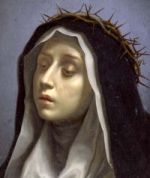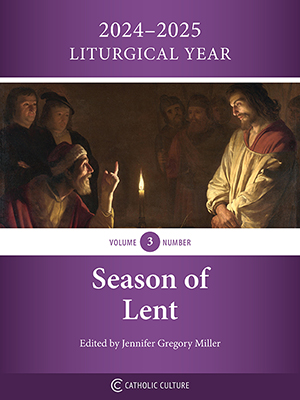Make your gift today!
Help keep Catholics around the world educated and informed.
Already donated? Log in to stop seeing these donation pop-ups.
Catholic World News News Feature
Full Text of the Third Secret Revealed October 11, 2001
by CWR staff
On Monday, June 26, the Vatican released the full text of the "third secret" of Fatima, Portugal, complete with a commentary by Cardinal Joseph Ratzinger, giving a detailed look at the message which has enthralled the imagination of millions for decades.
As the Vatican had already disclosed, the "third secret" comes in the form of a prophetic message--a vision of a struggle between the Church and a totalitarian system--and culminates with a vision of an assassination attempt on the Pope.
The text of the "third secret" was included in a 40-page document which also contained a theological commentary by Cardinal Ratzinger, an introduction by Archbishop Tarcisio Bertone, and several short texts that were apparently included to underline the authenticity of the text. The document was released through the Congregation for the Doctrine of the Faith, of which Cardinal Ratzinger and Archbishop Bertone are prefect and secretary, respectively.
Archbishop Bertone points out, in his introduction to the message, that the Fatima apparition is "undoubtedly the most prophetic" message from the Virgin Mary. He goes on to observe that it was inconceivable that in 1917, three young shepherd children would have predicted World War II and the rise of a totalitarian empire in Russia.
The full 40-page document made public by the Vatican explained that Pope John XXIII read the "third secret" in August 1959, but decided not to publicize it. Pope Paul VI made the same decision in March 1965. Soon after the attempt on his life on May 13, 1981, Pope John Paul II re-read the secret, and decided to consecrate the world to the Virgin Mary--an act which he carried out on June 7, 1981. Sister Lucia confirmed that this consecration fulfilled the wishes of the Lady of Fatima. Finally, Archbishop Bertone concludes his sketch of the history of the message by recalling that in May of this year, Pope John Paul decided to make public the full text of the Fatima secret. That decision, the archbishop writes, "brings to an end a period of history marked by tragic human lust for power and evil, yet pervaded by the merciful love of God and the watchful care of the Mother of Jesus and of the Church."
THE SECRET
Sister Lucia dos Santos, the only survivor among the three children to whom the Virgin Mary appeared at Fatima in 1917 and now a Carmelite nun, wrote down the text of the "third secret" in 1944, at the request of the local bishop. The following is the full text of the "third secret" in its original translation:
I write in obedience to you, my God, who command me to do so through his Excellency the Bishop of Leiria and through your Most Holy Mother and mine. After the two parts which I have already explained, at the left of Our Lady and a little above, we saw an Angel with a flaming sword in his left hand; flashing, it gave out flames that looked as though they would set the world on fire; but they died out in contact with the splendor that Our Lady radiated towards him from her right hand: pointing to the earth with his right hand, the Angel cried out in a loud voice: "Penance, Penance, Penance!" And we saw in an immense light that is God--something similar to how people appear in a mirror when they pass in front of it--a Bishop dressed in White--we had the impression that it was the Holy Father. Other Bishops, Priests, men and women Religious going up a steep mountain, at the top of which there was a big Cross of rough-hewn trunks as of a cork-tree with the bark; before reaching there the Holy Father passed through a big city half in ruins and half trembling with halting step, afflicted with pain and sorrow, he prayed for the souls of the corpses he met on his way; having reached the top of the mountain, on his knees at the foot of the big Cross he was killed by a group of soldiers who fired bullets and arrows at him, and in the same way there died one after another the other Bishops, Priests, men and women Religious, and various lay people of different ranks and positions. Beneath the two arms of the Cross there were two Angels each with a crystal aspergilium in his hand, in which they gathered up the blood of the Martyrs and with it sprinkled the souls that were making their way to God.
PRIVATE REVELATION
In the original release of the message in May, during the Pope's visit to Fatima, Cardinal Angelo Sodano explained the "third secret" in general terms, linking the "bishop dressed in white" in a fight with atheistic systems to the assassination attempt against the Holy Father in May 1981.
In his theological commentary, Cardinal Ratzinger emphasizes that the key to understanding the Fatima message lies in the words: "Penance, penance, penance!"
Cardinal Ratzinger adds that a second crucial aspect of the Virgin's message is her reassurance that "my Immaculate Heart will triumph."
In the first part of his commentary, the cardinal carefully places the Fatima message in its proper context, as a "private revelation." He explains that private revelations must be distinguished from the definitive public revelation that is contained in the Scriptures as interpreted through the Tradition of the Church.
"In Christ, God has said everything--that is, he has revealed himself completely--and therefore Revelation came to an end with the fulfillment of the mystery of Christ as enunciated in the New Testament," the German prelate writes.
However, private revelations may and do continue, in the form of various apparitions, admonitions, and messages. A private revelation, Cardinal Ratzinger explains, "is a help to this faith, and shows its credibility precisely by leading back to the definitive public Revelation."
The Church, through her hierarchy, judges the authenticity of private revelations. In some cases--such as the Fatima apparitions--the Church offers a public approval of the message. In such cases, Cardinal Ratzinger writes, the message can be "a genuine help in understanding the Gospel and living it better at a particular moment in time; therefore it should not be disregarded. It is a help which is offered, but which one is not obliged to use."
SYMBOLIC INTERPRETATION
Turning to the content of the "third secret," the cardinal writes that the prophetic vision which was disclosed to the three young children who saw the Virgin Mary at Fatima was a preview of the 20th century. "In the vision we can recognize the last century as a century of martyrs, a century of suffering and persecution for the Church, a century of world wars and the many local wars which filled the last fifty years and have inflicted unprecedented forms of cruelty."
That vision is coupled with Mary's plea for prayer and penance, Cardinal Ratzinger continues. And taken as a whole, the Fatima message is a strong reminder that the crises of the world must finally be resolved not through armed force but through prayer and reliance on God's grace. Thus despite its violent imagery and its strong warning tone, the Fatima message concludes with a note of confidence: "my Immaculate Heart will triumph."
"To understand the signs of the times," the cardinal writes, "means to accept the urgency of penance, of conversion, of faith. This is the correct response to this moment of history, characterized by the grave perils outlined in the images that follow."
Cardinal Ratzinger discloses that he spoke with Sister Lucia about the content of the entire Fatima message. He reports that "Sister Lucia said that it appeared ever more clearly to her that the purpose of all the apparitions was to help people to grow more and more in faith, hope, and love--everything else was intended to lead to this."
In the "third secret," Sister Lucia writes about the vision of an angel with a flaming sword. That image, Cardinal Ratzinger notes, is a common one from the Book of Revelations, and it represents "the threat of judgment which looms over the world." During the 20th century, when warfare threatened millions of people with instant annihilation, that threat of judgment became particularly immediate, he observes.
However, the cardinal continues, the threat is balanced by the image of "the splendor of the Mother of God." And in her message to the children of Fatima, the Virgin Mary emphasized the need for prayer and penance.
"In this way, the importance of human freedom is underlined," Cardinal Ratzinger writes. The dangers that threaten the world can be avoided if people answer Mary's call to penance. In short, the cardinal explains, "the vision speaks of dangers and how we might be saved from them."
However, he concludes, the vision ends with a powerful expression of hope, echoing the Virgin's promise that "my Immaculate Heart with triumph." This, the cardinal points out, is a reminder of a basic tenet of faith. "The 'fiat' of Mary, the word of her heart, has changed the history of the world, because it brought the Savior into the world." In his analysis of the message, Cardinal Ratzinger directly addresses the theories which have been put forward by many amateur theologians, suggesting that the Fatima message--and, in particular, the "third secret"--contained extraordinary news about the end of the world or about apostasy within the Church. Those analyses were wrong, writes the prefect of the Congregation for the Doctrine of the Faith.
Cardinal Ratzinger writes: "Those who expected exciting apocalyptic revelations about the end of the world or the future course of history are bound to be disappointed. Fatima does not satisfy our curiosity in this way, just as Christian faith in general cannot be reduced to an object of mere curiosity."
NOT THE REAL MESSAGE?
Despite the cardinal's admonition, some continued to dispute the official Vatican interpretation of the secret and pushed for an understanding that included apocalyptic dimensions.
Some have said the message released by the Vatican is not the "real secret" or point to other approved apparitions that they say contradict the Fatima interpretation. According to the messages received in the apparitions of Akita, Japan, in 1973, a symbolic vision purports to show "the work of the devil will infiltrate the Church … cardinals opposing cardinals, bishops against bishops." Supporters of this message said the Fatima message and Akita message are related.
Howard Dee, former Philippine ambassador to the Vatican, said in a 1998 interview with Inside the Vatican magazine: "Bishop Ito [the local bishop, now deceased] was certain Akita was an extension of Fatima, and Cardinal Ratzinger personally confirmed to me that these two messages, of Fatima and Akita, are essentially the same."
However, while both Bishop Ito and Cardinal Ratzinger declared the messages and events in Akita to be of supernatural origin and labeled them "worthy of belief," there was no final approval and no judgment on the actual message.






